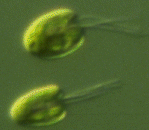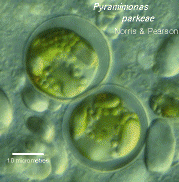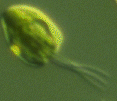Introduction to the Micromonadophyceae
 The Micromonadophyceae are a "primitive" group of green flagellates that
has only recently been recognized, and so is relatively poorly known and
little studied. The group is now attracting much attention, as it is believed to
be representative of the earliest ancestors of the
green algae and plants. However,
the group is not based on any synapomorphies, and so may not be a natural,
or monophyletic, group.
The Micromonadophyceae are a "primitive" group of green flagellates that
has only recently been recognized, and so is relatively poorly known and
little studied. The group is now attracting much attention, as it is believed to
be representative of the earliest ancestors of the
green algae and plants. However,
the group is not based on any synapomorphies, and so may not be a natural,
or monophyletic, group.
Micromonads occur in both fresh and marine water, where they exist as
free-swimming unicellular organisms. They will occasionally undergo
encystment, losing their flagella, becoming dormant, and encasing
themselves in a resistant wall. These cysts, such as the ones shown at
left below, may be highly ornamented, and
have many structural similarities to the spores of
land plants. Such cysts are found as fossils
as early as the Precambrian, but their interpretation as micromonads is not
entirely certain -- there are other unicellular green algae which produce
similar cysts.
 Most micromonads have scales over the surface of their cell membrane and
on their flagella. This is in contrast to the cell wall found in plants,
and the theca-like wall of the green algae. The scales arise within
the Golgi apparatus, and are then transferred by a vesicle to the
apical end of the cell. The scales are often highly complex, and may be of
several forms on a single cell, sometimes in several layers or arrangements
on a single individual. Not all micromonads have these scales however;
some have secondarily become naked through reduction of the cell and
loss of scale production.
Most micromonads have scales over the surface of their cell membrane and
on their flagella. This is in contrast to the cell wall found in plants,
and the theca-like wall of the green algae. The scales arise within
the Golgi apparatus, and are then transferred by a vesicle to the
apical end of the cell. The scales are often highly complex, and may be of
several forms on a single cell, sometimes in several layers or arrangements
on a single individual. Not all micromonads have these scales however;
some have secondarily become naked through reduction of the cell and
loss of scale production.
The micromonads have an unusual structure of flagellar attachment among
green algae, and some species have a mix of flagellar attachments that are
not normally found together in the other groups of the Chlorophyta. Instead
of arising from a papilla, or bump, at the apex of the cell, the
flagella extend out from an apical or lateral depression. Out of this
depression may arise two, four, or eight flagellae. The wide variety of
flagellar arrangements and numbers in this group of green algae suggest that
it may be a holdover from an early diversification, and therefore a basal
group among green organisms.
 The Micromonadophyceae was originally named the Prasinophyceae, and
was created as a place to put a number of unicellular forms which were
found to be very different from the Chlorophyceae, with which they had
previously been classified. These taxa are now known to be different in
having many primitive characters, and so the group is not based on derived
characters as it ideally should be. A confounding problem came when the
type genus of the Prasinophyceae, Prasinocladus was
synonymized with Tetraselmis, a genus now placed in the
Pleurastrophyceae.
Since the name of the class relies on containing the
defining genus, the old name Prasinophyceae can no longer be properly used.
The Micromonadophyceae was originally named the Prasinophyceae, and
was created as a place to put a number of unicellular forms which were
found to be very different from the Chlorophyceae, with which they had
previously been classified. These taxa are now known to be different in
having many primitive characters, and so the group is not based on derived
characters as it ideally should be. A confounding problem came when the
type genus of the Prasinophyceae, Prasinocladus was
synonymized with Tetraselmis, a genus now placed in the
Pleurastrophyceae.
Since the name of the class relies on containing the
defining genus, the old name Prasinophyceae can no longer be properly used.
Try the Protist Image Data Base for information about
Pyramimonas, a living micromonad.

Source:
K.R.Mattox and K.D.Stewart. 1984. Classification of the green algae:
a concept based on comparative cytology. Pp.29-72 in Systematics
Association Special Volume No. 27, "Systematics of the Green Algae", edited
by D.E.G.Irvine and D.M.John, Academic Press, London and Orlando.
Images used on this page provided courtesy the PID, and should not be
used without their permission.


 The Micromonadophyceae are a "primitive" group of green flagellates that
has only recently been recognized, and so is relatively poorly known and
little studied. The group is now attracting much attention, as it is believed to
be representative of the earliest ancestors of the
green algae and plants. However,
the group is not based on any synapomorphies, and so may not be a natural,
or monophyletic, group.
The Micromonadophyceae are a "primitive" group of green flagellates that
has only recently been recognized, and so is relatively poorly known and
little studied. The group is now attracting much attention, as it is believed to
be representative of the earliest ancestors of the
green algae and plants. However,
the group is not based on any synapomorphies, and so may not be a natural,
or monophyletic, group.

 The Micromonadophyceae was originally named the Prasinophyceae, and
was created as a place to put a number of unicellular forms which were
found to be very different from the Chlorophyceae, with which they had
previously been classified. These taxa are now known to be different in
having many primitive characters, and so the group is not based on derived
characters as it ideally should be. A confounding problem came when the
type genus of the Prasinophyceae, Prasinocladus was
synonymized with Tetraselmis, a genus now placed in the
The Micromonadophyceae was originally named the Prasinophyceae, and
was created as a place to put a number of unicellular forms which were
found to be very different from the Chlorophyceae, with which they had
previously been classified. These taxa are now known to be different in
having many primitive characters, and so the group is not based on derived
characters as it ideally should be. A confounding problem came when the
type genus of the Prasinophyceae, Prasinocladus was
synonymized with Tetraselmis, a genus now placed in the


